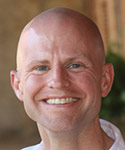While I was a graduate student in theology and blissfully free of any ecclesiastical responsibility, I used to criticize the theologically naïve pastors who focused on numerical growth. Then I became a pastor, and I swallowed a healthy dose of realism --“These people are paying my salary; I’d better start caring about numbers.” So I’d sneak into the sanctuary with calculator in hand, find the clip board under the back pew where our faithful head-counter sat each week, and make my tally.
Now when I criticize myself, it’s not for caring about the numbers, but for a failure of imagination. Counting attendance, membership, and professions of faith -- that’s easy, but it doesn’t tell you much about the health or vitality of a church. Why have we failed to be more creative about which numbers we count?
Jim Collins, in “Good to Great in the Social Sectors,” gives an example of an organization getting creative about measurement. For organizations in the social sector, the bottom line is not the bottom line. The question for these organizations, Collins writes, is not “‘How much money do we make per dollar of invested capital?’ but ‘How effectively do we deliver on our mission and make a distinctive impact, relative to our resources?’” Being in the social sector does not absolve an organization of the responsibility to measure rigorously. It just calls for more creativity about what you are going to measure if you want your measurements to say anything about how well you are achieving your mission.
Collins points to The Cleveland Orchestra. When Tom Morris became executive director in 1987 The Cleveland Orchestra was struggling. It would have been easy to set as a goal to sell more tickets. But they wanted to become one of the three greatest orchestras in the world (their Big Hairy Audacious Goal, in Collins-speak). How do you measure that?
They started counting standing ovations. They started tracking the expansion of their repertoire. They started counting how many prestigious festivals they were invited to. They started measuring ticket sales, especially when they were playing somewhere other than Cleveland. They started asking how often composers wanted to have their new works debuted at Cleveland. By being creative about what indicators would measure their growth in artistic excellence The Cleveland Orchestra was able to be held rigorously accountable to achieving their mission.
And if it’s possible for an orchestra, I imagine it’s possible for a church.
When I counted worship attendance I wasn’t holding anyone rigorously accountable to anything. But what if each church gathered a team of its most creative, faithful thinkers and asked, “What about our life together might indicate our faithfulness as a sign and foretaste of God’s Kingdom?” What indicators might actually tell us something about the vitality, health and faithfulness of a congregation? I wonder how the focus of a pastor’s ministry might change (along with his or her anxieties) if bishops and judicatory leaders asked each year, “How many new small group leaders did you equip last year?” or “How many third time guests came to your church last year?” or “What is the ratio of the number of participants in small groups to the number of people in worship to the number of members?” (I suspect how that ratio changes might actually say something about the growth or decline of a congregation’s vitality). Or “How long does it take for your sanctuary to empty after worship?” Or this: “How many members of the congregation had a meal with a homeless person this year?”
We pastors should not retire our calculators. But we should learn to do something more creative with them than add a list of numbers together and divide by 52. It might be hard to measure faithfulness to the Kingdom of God. But if we care about what God is doing through this institution we call church, then we’d sure better try.
Roger Owens is co-pastor of Duke Memorial United Methodist Church in Durham, NC.








